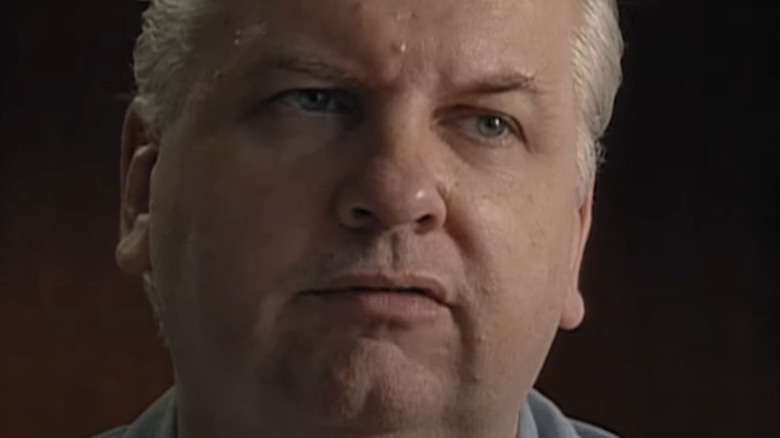How One Of John Wayne Gacy's Victims Helped Bring Him To Justice
We may receive a commission on purchases made from links.
When investigators executed a search warrant at 8213 West Summerdale Avenue in the Norwood Park neighborhood of Chicago in 1978, they stumbled across one of the most horrific crime scenes of the 20th century (via Newsweek). While on a search that detectives believed would yield the body of recently missing 15-year-old Robert Piest, they instead discovered the remains of 29 different young men and boys in the crawl space and other places on the property (per Biography).
The homeowner, John Wayne Gacy, would later go on trial for the sexual assault and murder of 33 males. Sentenced to die by lethal injection after his trial in 1980, Gacy's continued to maintain his innocence until he was finally put to death in 1994. Though the search for Piest and the detective work that immediately followed the grisly discovery on Gacy's property that December day in 1978 led to Gacy's arrest and conviction, a victim from Gacy's not too distant past helped bring him to justice. It's the story of how one really lucky man barely escaped death and used his own detective skills to help convict one of the most notorious serial killers in United States history.
Jeffrey Rignall met Gacy by chance in 1978
Jeffrey Rignall was visiting Chicago from Louisville, Kentucky, in March 1978. The Associated Press reports that the 26-year-old was walking to a gay bar when John Wayne Gacy pulled up beside him in an Oldsmobile. After a bit of conversation, Gacy invited the young man to join him back at his home in the Chicago suburbs.
Rignall obliged, and the two men rode to Gacy's house on Summerdale Avenue. After settling in for the ride, Rignall and Gacy began smoking marijuana from a joint. Rignall asserts that after he had taken several drags off of the joint, Gacy forced a rag over his face, causing the passenger to lose consciousness. After being out for several minutes, Rignall began to awaken, which prompted Gacy to force the cloth over his face once again.
It's been surmised that Gacy used a rag doused with chloroform to render his victim incapacitated. Rignall vaguely recalled being carried into a house by Gacy. When the man fully regained his faculties, he was on a sofa opposite a home bar where Gacy stood making himself a drink. After threatening Rignall with a gun, Gacy tied his victim up. He then repeatedly raped and tortured Rignall, frequently employing the use of chloroform to aid him in his monstrous crimes (per Oxygen).
Why Gacy didn't murder Rignall is up for debate. What is known is that Gacy spared the life of his victim, dumping him off at a Chicago park.
If you or anyone you know has been a victim of sexual assault, help is available. Visit the Rape, Abuse & Incest National Network website or contact RAINN's National Helpline at 1-800-656-HOPE (4673).
Rignall was abandoned in horrific physical shape
Oxygen reports that the park where John Wayne Gacy left Jeffrey Rignall was not far from the spot where the two men initially met. Rignall was in pretty bad shape. His body was covered in rope burns from being tied by his captor and bruised from the savage beatings that Gacy had inflicted upon him. Photographs of Rignall taken soon after reveal that his face was severely burned in multiple areas, the result of being exposed to copious amounts of chloroform. He was also bleeding from his rectum, the result of Gacy's repeated sexual assaults.
Though probably still dazed from the horrors he had just endured, Rignall began to get himself together enough to make his way to a hospital. There was a mountain of evidence that he had been held captive, beaten, and brutally physically and sexually assaulted. But despite all of the tell-tale signs that multiple crimes had been committed against him, Rignall found that the police were less than cooperative.
The homophobia that existed in the 1970s may have kept Gacy from getting brought to justice sooner
Jeffrey Rignall presented a pretty strong case that he had been physically and sexually assaulted after being rendered unconscious. When being interviewed by the police at the hospital, he could not present many identifying details about his attacker, though he was able to recall the model car he was driving. He even remembered some of the landmarks around the home that he was taken to by his abductor. Oxygen reports that William Kunkle, retired judge of the Circuit Court of Cook County, recalled that Rignall's story was very vague and lacked sufficient details for the police to work up a case or generate any leads. Years later, Rignall's partner Ron Wilder refuted that, stating that the police didn't take his case seriously because of Rignall's sexuality. The police, according to Wilder, were convinced that Rignall's encounter with his attacker was purely consensual. His opinion was that police had too many preconceived notions about gay relationships, causing them to gloss over Rignall's attack as a minor incident.
According to Wilder, Rignall was convinced that his attacker was capable of murder. Rignall was driven to identify the man who attacked and assaulted him and bring him to justice.
Rignall was a fairly good amateur detective
Jeffrey Rignall began putting together the pieces in an attempt to identify who had assaulted him. He remembered that he was taken for a ride in the man's Oldsmobile and also had a rough recollection of the license plate number. He had a memory of the sound of airplanes flying overhead when he was at his attacker's home, signaling that an airport was nearby. He knew that the park he was left in was near where he was first picked up (via Oxygen).
Rignall rented a car and began a series of stakeouts. He was accompanied by Ron Wilder, who sat with him at a spot near where Rignall believed he was attacked. The two men were waiting to spot an Oldsmobile that fit the description Rignall recalled. It took nearly a month and several location changes before Rignall found the vehicle he was looking for. He carefully followed the Oldsmobile and was able to get a complete license plate number. He took his information to the police, who managed to get a warrant for his arrest. According to "John Wayne Gacy: Defending a Monster," Gacy was charged with sexual assault on July 15, 1978. The New Yorker reports that Rignall later settled with Gacy for $3,000.
Though Gacy never served time for the assault, it was Rignall's persistence and keen detective work that led to the assault charge against him. And it meant that Gacy was becoming more and more known to police, which may have led them to pursue Gacy as a prime suspect when his final victim, Robert Piest, disappeared several months later.
Rignall testified in court at Gacy's murder trial
John Wayne Gacy was tried for 33 counts of murder in a trial that began in February 1980 (via Biography). As he had already confessed the murders to police, the trial was more focused on whether or not Gacy was sane or insane when the murders were committed. Jeffrey Rignall took the stand, surprisingly, as a defense witness. Though initially considered a witness for the prosecution, the state felt they could strengthen their case during the cross-examination of Rignall as a defense witness.
Rignall's time on the stand was harrowing. Encyclopedia.com reports that while recounting the horrors that were forced onto him, he became hysterical on the stand. At one point, he vomited and had to be escorted out of the courtroom. Rignall and Wilder co-wrote a book detailing his experiences, "29 Below," which was published in 1979 and is since out of print.
Rignall passed away from AIDS-related complications in 2000 at the age of 49 (per Oxygen).





